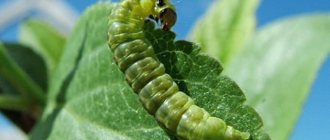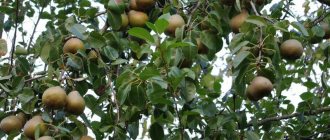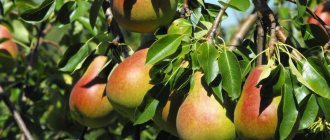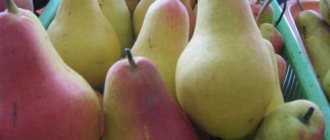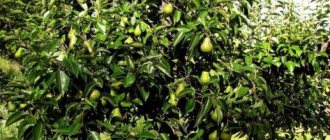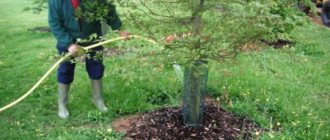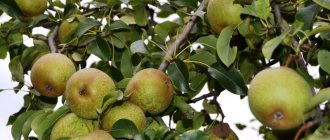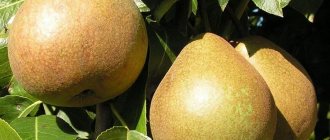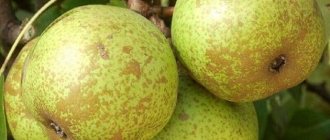It is almost impossible to buy a pear variety of the old domestic selection Severyanka now. Nurseries have stopped breeding it. However, Severyanka is still often found in private courtyards in the Urals. The variety is loved by many gardeners because of its tasty fruits, so many fans propagate it by grafting. The Severyanka pear was bred by crossing two varieties: Lyubimets Klappa and Koperechka.
History of the variety's creation
In 1959, as a result of crossing two pears - Klapp's Lyubimitsa and Koperechka Michurinskaya No. 12 - a new variety was developed. On the basis of the Michurin Institute, the development was carried out by P. N. Yakovlev, the new pear was initially named in honor of its creator “Yakovlev Seedling No. 103”.
Severyanka is a widespread variety of pears, which was created by the famous breeder P. N. Yakovlev. The variety was created for cultivation in the north, including the Urals, so the pear later received the appropriate name - Severyanka.
The spread of the new hybrid form began immediately after control tests. Today, pears are not grown on an industrial scale, but continue to be distributed for amateur gardening.
Fruit characteristics
Ripe pears have a conical shape, their contours resemble a light bulb. At the beginning of ripening, the fruits have a dull color, in which there are yellow, green shades, and sometimes red is added.
In early August, more saturated yellow and red colors begin to dominate the color. The fruits of the Severyanka pear are distinguished by their strong skin.
The weight of one pear can reach 100 g. The pulp is creamy in color, juicy and sweet in taste, and has a dense but not hard consistency. When cutting the fruit, a barely noticeable aroma is felt.
Description of the variety
Severyanka is distinguished by high shoot formation and resistance to winter cold and temperature changes. The variety gives a rich harvest even after harsh winters.
Tree
Pear belongs to the category of medium-sized trees. It reaches about 5-6 m in height.
The wide-pyramidal crown with a diameter of up to 6 m is moderately thick, shoots form quickly. Skeletal branches extend at an acute angle from the trunk. To facilitate care and harvesting, they must be pulled back in the first years after planting, increasing the angle of departure from the trunk.
The tree has a crown in the shape of a wide pyramid, with a diameter of up to 6 meters
The leaves are dark green in color, the plate is slightly concave, and the tips are pointed. Young shoots are slightly fleecy and green in color, while woody shoots become gray in color and their bark is smooth. The inflorescences resemble saucers and consist of 4-6 white flowers.
Winter hardiness
Severyanka is a winter-hardy variety. This pear can withstand frosts down to -40...-50 °C. But in snowless and harsh winters, the branches of the crop may die, but the roots will remain viable. Thanks to this, the tree will quickly recover. To increase the winter hardiness of young seedlings, it is advisable to prepare it for the cold period.
Algorithm of actions:
- In the fall, after the onset of frost, wrap the trunk of the seedling with burlap or fine metal mesh. Such a barrier will protect the plant from rodent invasion. Mature trees can simply be whitened by treating the trunk and skeletal branches with a solution.
- Cover the trunk circle of the seedling with a 10-centimeter layer of pine needles, compost, peat or humus. The stem is additionally tied with spruce branches or agrofibre.
- In winter, shovel a thick layer of snow under the tree trunk.
You can remove the mulch in early spring, as soon as the snow melts.
Main characteristics
Pear Severyanka lives 35-60 years. The variety is very winter-hardy, which makes it common in regions with harsh climates. Fruiting is characterized by a two-year cycle, self-fertility is weak, pollinators are required.
Winter hardiness
Severyanka has high frost resistance, can withstand temperatures down to minus 40 degrees, and reacts normally to sudden temperature changes.
Severyanka has high frost resistance
There is a risk of freezing of the above-ground part during critically severe frosts, but the roots retain their viability. The shoots quickly recover, and the pear continues to bear fruit. This characteristic makes it possible to grow pears in regions with harsh winters.
Young trees should be protected from upcoming frosts. Their trunk is insulated with burlap and spruce branches. In winter, cover with snow as much as possible.
Taste qualities
The fruits are very juicy and crispy, moderately sweet and moderately sour. There is no astringency, you can feel small granules, which is typical for most northern pears.
The fruits taste sweet with sour notes
Approximately 8-10 days after harvesting, the pulp becomes loose and darkens. Taste quality deteriorates significantly.
Varieties
Severyanka is often used to breed new varieties. The Northern Red-cheeked pear has become very popular. In terms of tree height and crown shape, the variety is similar to the usual Severyanka.
Red-cheeked is characterized by high shoot formation, but the thickness of the branches is less than that of the mother variety. The fruits are uniform in size, but smaller than those of Severyanka.
Red-cheeked also differ from its “mother” in a more pleasant taste and aroma, and its frost resistance is even higher. When fully ripe, the skin of the fruit becomes covered with a pink blush on the sunny side.
Severyanka Red-cheeked has good taste
Pollinators
The variety is partially self-fertile; when grown alone, about a third of the ovaries of all inflorescences are formed. To increase the yield, Severyanka should be grown with pollinating neighbors. The best pears are the Yakovlev memory variety, Rogneda pear, the description of the variety can be found separately, Permyachka pear, Krasulya.
Severyanka itself is considered an excellent pollinator for other pears with a similar flowering period (April-May).
Varieties
Using the Severyanka variety and the Krasnoshchekaya variety, another hybrid was bred, called Severyanka Krasnoshchekaya. It has become widespread in the Central Black Earth region. The maximum height of a tree at ten years of age does not exceed 6 meters. The crown of medium density has an almost rounded shape. Shoots form quickly, but are thinner than those of Severyanka. Mid-season variety with summer fruiting. Unlike the mother variety, the fruits do not have such a wide range in size, and the weight of the fruit is somewhat less. This hybrid has very high resistance to scab and some insects. This article will tell you what to do if pears rot on a tree.
The Severyanka Red-cheeked pear has a more pleasant taste and aroma, and in terms of winter hardiness and unpretentiousness, the variety is noticeably superior to the mother specimens.
Advantages and disadvantages of the variety
The variety has the following advantages:
- High resistance to low temperatures, rapid restoration of the tree after freezing with continued fruiting.
- Good immunity to diseases and pests, including scab.
- High stable yield.
- The versatility of fruit use.
- Easy care at home.
The disadvantages of Severyanka include:
- Average taste.
- Fully ripe fruit tends to shed.
- Small fruit size.
- Short shelf life.
The disadvantage of this variety is that the fruits are small.
The crop does not tolerate long-term transportation very well, which is not convenient for all gardeners.
Reviews from summer residents
- Severyanka has been growing in our dacha for 7 or 8 years. We have never had any problems with yield or diseases and pests. Yes, every spring before flowering we carry out preventative treatment of trees and carefully remove foliage in the fall. The pears of this variety are tender and tasty.
- I like this variety most of all for its tasty and juicy fruits. I don’t like hard or tart pears, and it’s also annoying if the pear has these characteristic inclusions like small pebbles. Severyanka has slightly dense and tender flesh. We enjoy eating with the whole family. And the variety’s yield is good, we eat it this way, with the whole large family, we also make jam and store some in the cellar.
- I like Severyanka because even in our cold climate there is a good harvest every year. There are not many tasty varieties of fruit trees suitable for growing in the northern regions, but you are lucky with pears. Severyanka not only produces tasty fruits that can be eaten and processed, preserving nutrients for the winter, but also tolerates winter and spring frosts well.
Landing
The area for growing pears should be protected as much as possible from cold winds and drafts and provide good lighting for the entire plant. The northern woman prefers sandstone and loam.
The area for growing pears must be protected from cold winds and drafts
It is important to pay attention to the depth of groundwater; it should be higher than 2 meters from the surface of the earth.
When choosing a landing site, lowlands should be excluded. High humidity and cold negatively affect the development of pears.
What is the best thing to grow from?
The following can be used as planting material:
- seedlings;
- stalk;
- sunflower seed;
- offspring.
Pear seedlings
Pear cuttings
Pear seeds
Reproduction by root suckers
For this pear, propagation by seed is used extremely rarely, since the process of its germination is long and complex. The disadvantage of this method is the possibility of obtaining an unexpected result when the resulting seedling differs in characteristics from the mother material.
The technology for rooting cuttings and offspring has many nuances, so this option for propagating pears is best done by experienced gardeners.
The most reliable and simplest way to grow a pear in your garden is to plant ready-made seedlings, which are purchased from specialized nurseries and gardening farms.
Deadlines
Autumn and spring are suitable for planting. Depending on climatic and weather conditions in the spring, planting work is carried out from late April to early May. This period is recommended for northern latitudes, where in winter the air temperature drops critically low. Over the summer, the tree will take root and become stronger, which will allow it to withstand the onset of cold weather well.
Pear variety Severyanka can be planted in spring or autumn
In autumn, October-early November is chosen for planting. It is recommended to plant seedlings for the winter in regions where severe frosts are extremely rare. Otherwise, even insulation may not help, and the young tree will die.
In areas with mild winters, fall planting has an advantage. The root system develops even when the tree is dormant, so the seedling will take root well without wasting energy on growing the above-ground part. In the spring, the rooted tree will comfortably enter the growing season.
Selection of seedlings for planting
It is recommended to give preference to two-year-old seedlings as planting material.
Planting of one-year and three-year-old trees is allowed. Pears over 3 years old have a fairly developed root system, and when they are transplanted, the risk of damage to the root processes increases. When purchasing a seedling, you need to pay attention to the condition of the trunk, branches (if any) and roots.
Rules for choosing a fruit seedling
There should be no damage or signs of disease on the seedling, the leaves should look healthy. The roots are not allowed to show signs of rotting, growths, or a large number of dry shoots. Ideal roots are light, elastic and slightly moist.
Distance between trees
Pear is a light-loving crop, so when planting several seedlings, it is necessary to take into account the need for sufficient lighting of the crown as the tree grows. A minimum distance of 5 m must be maintained between plants.
Technology and agricultural technology
Soil preparation should be done 2 weeks before autumn planting. The earth is dug up, weeds are removed, and leveled. Organic fertilizer is applied (7 kg per 1 m2).
Before planting a seedling, it is necessary to prepare the soil
When planning planting work in the spring, the site is prepared in the fall.
The seedling is inspected, damaged, rotten or dried roots are cut off with a sharp blade.
If necessary (in case of long-term storage of seedlings after purchase), the heavily dried root system is placed in water for 12-24 hours.
Planting a seedling is carried out in the following sequence:
- In the prepared area, dig a hole about 1 m deep and 70-80 cm in diameter. The walls must be smooth.
- The extracted soil is mixed with peat, river sand and humus in equal parts, and 400-600 g of superphosphate is added. Mix everything well, lay a layer of drainage at the bottom of the hole (on light soils it can be omitted).
- A mound is formed from part of the prepared mixture at the bottom of the pit. The height is controlled by trying on the seedling. Its root collar, after filling the hole, should be located approximately 4 cm above ground level.
- A wooden peg about 1.5 m high is driven in near the center of the bottom on the north side of the seedling.
- Spread the roots evenly over the mound. They begin to fill the hole with soil and fertilizer, reducing the number of voids by shaking the seedling.
- After filling the hole, the soil is lightly compacted and a radial ditch is formed, retreating 15 cm from the trunk.
- Water the tree with 2-3 buckets of water. They loosen the ground. The tree trunk layer is mulched with peat, humus or crushed tree bark in a 10 cm layer.
The seedling is tied to a peg with soft twine, a piece of fabric or linen thread.
Scheme of planting a pear seedling
Characteristics
With careful care and proper watering, the pear yield is about 45-60 kg. Under favorable weather conditions in summer, up to 100 kg can be collected from one tree.
Severyanka is a high-yielding variety . The first sign of complete ripeness is the appearance of an even yellow color on the skin, but the seeds continue to remain white. The fruits are not one-dimensional in size.
Pear harvesting begins on the tenth day of August and continues almost until the end of the month . By the end of this period, the fruit pulp becomes brown.
Fruits that have reached full ripeness completely fall off the tree within 2-3 days . The fruits are stored for about 10 days in a cool room in wooden or wicker containers.
Experts recommend harvesting 5-7 days earlier to prevent fruit falling . And besides, fruits collected in advance are stored in a cold cellar or refrigerator for up to two months.
When this variety self-pollinates, only up to 30% of the fruits are set. Therefore, this variety needs a pollinator.
It is useful to plant Severyanka in the vicinity of the Pamyati Yakovlev , which is the best option for its pollinator.
This variety has high winter hardiness and average drought resistance. Cases have been recorded in Ufa when, during short-term frosts of 50 degrees, only young trees froze completely.
And when the temperature dropped for a long time to -42 degrees, the above-ground part died, but the trees quickly recovered. If there is a lack of moisture, the fruits become smaller , the taste becomes worse, and the harvest is delayed by one to two weeks.
Winter-hardy pear varieties also include: Yakovlevskaya, Chudesnitsa, Feeria, Quiet Don and Tatyana.
Care
A young pear needs regular watering, removal of nearby weeds, periodic feeding and pruning. If a sufficient amount of fertilizer is applied during planting, the next fertilizing is carried out after 3-4 years.
Watering
Humidification should be moderate; a lack of moisture will negatively affect the taste of the fruit and its size will decrease. On average, a tree is watered about 6 times per season.
The best method of watering pears is sprinkling.
It is especially important to water during periods of shoot growth, bud formation and fruit set.
Preference is given to the sprinkling method. If such irrigation is not possible, it is better to make a radial groove inside the trunk circle with a depth of about 15 cm and a width of about 50 cm.
An earthen roller is formed near the trunk itself, which will prevent the wood from flooding. Water is poured into the trench in buckets or through a hose (for a tree under 10 years old - about 2-4 buckets of water).
After watering the young tree, the ground is loosened and weeds are removed.
Top dressing
From the moment of fruiting, the tree needs additional nutrition:
- In the spring, before the buds open, nitrogen-containing compounds are used. 700 g of urea are dissolved in 10 liters of water and poured into a trench for irrigation.
- After flowering, nitroammophoska is used. 50 g of the substance is diluted in 10 liters of water, the solution is watered on the tree without wetting its trunk.
- In autumn, pears need phosphorus-potassium complexes. Superphosphate can be added in dry form for digging at the rate of 40-60 g (2-3 tbsp) per 1 m2 of tree trunk circle. You can pour in an aqueous solution; dissolve 2 tbsp in 10 liters of water. l. superphosphate and 1 tbsp. l. potassium chloride.
Organic fertilizers are applied in the fall once every three years when digging the soil. Use compost or humus and wood ash at the rate of 9 kg of organic matter and 150 g of ash per 1 m2.
Fertilizer for pears must include nitrogen.
Trimming
For the first time, a tree is pruned immediately after planting. If skeletal branches have not yet formed on it, then the trunk is cut to 90 cm. If they are present, the branches are cut by a third, and 3 buds are left on each of them.
Scheme for correct pruning of pears
In spring and autumn, inspect the tree for frostbitten, broken, damaged shoots. They are carefully removed with a sharp knife or pruning shears.
Shading of fruiting branches reduces the tree's yield and fruit quality.
It is necessary to control the degree of crown thickening. In early spring or autumn, after cleaning the garden, remove branches that grow inward, located downwards or vertically upwards.
Rejuvenation
With a noticeable slowdown in the growth of young shoots, as well as with a decrease in yield, the tree needs rejuvenating pruning.
Experienced gardeners call this procedure creative work. First you need to get rid of dead branches. Most often, these include shoots that have frozen over the winter. Overgrown tops and non-fruiting branches also need to be removed; for this you need to know how to trim the tops on a pear correctly.
Scheme of rejuvenating pear pruning
Afterwards thinning pruning is carried out. Remove branches that strongly shade the crown and grow downward and inward.
For very old trees, if it is necessary to cut down several large branches, the event is divided over a couple of years.
Too much pruning has a negative impact on the condition of the tree and can create a stressful situation for it.
Planting and care
To plant this plant, you should choose a sunny place protected from the wind. It is recommended to prepare the planting hole in advance, two to three weeks before purchasing seedlings.
Place manure and humus . Its size will be 60 cm in depth and about 90-100 cm in width.
The first pruning of the pear is done after planting. If the seedling has no skeletal branches at all, the plant has one shoot, it is advisable to cut it at a height of 70-90 cm above the ground and preserve at least three developed buds.
This type of pruning is carried out every spring for several years after planting the tree.
Pears love moisture very much , and therefore watering is done several times in spring and summer .
Fertilize in the second year of the tree’s life. For the winter, it is necessary to insulate young trees because they may suffer from the cold.
Watch the video master class on pear pruning:
Collection and storage of fruits
Pears can be picked from the moment their skin begins to turn yellow. In this state, the shelf life can be extended to 2 months. Whole and dry pears are placed in ventilated boxes and stored in the refrigerator.
Fully ripened fruits (yellow in color) fall off and are only suitable for processing.
It is easier to harvest from an adult tall tree using special devices.
You can use special tools to remove pears
Description of fruits
Pears are usually medium in size, their weight ranges from 80 to 100 grams. The shape of the fruit is conical. During harvest, their color may be green-yellow, but later it turns into a rich yellow with small green areas. The skin is not too rough, but very dense.
The pulp also has a dense structure, creamy color, and has a faint pleasant aroma. It tastes sweetish with sour notes. There are few seeds, they are large in size. The shelf life usually does not exceed a couple of weeks. In the refrigerator this period can be extended to two months.
Diseases and pests
Severyanka pear has good resistance to attacks by the pear gall mite, codling moth, and scab. However, it is not 100% protected from diseases. A gardener may encounter the following pear lesions:
- Powdery mildew. The vegetative parts cannot fully develop, the leaves crumble, and the tops of the shoots dry out. As a result of the disease, yields can be reduced by almost half. After a wet and mild winter, before the buds open, it is necessary to carry out preventive spraying of the pear with Tiovit Jet, Rayok. When the first signs are detected, Horus and Speed have proven themselves well in treatment.
- Fruit rot. Most often, the signs are noticeable on the fruits; brown spots appear on them, gradually increasing in volume. In advanced stages, mycelium becomes visible in the affected areas. The fruits completely darken and dry out, but remain hanging on the tree, becoming a wintering site for fungal spores. Fruit rot also affects other pome crops; if signs of the disease are detected on other trees or in neighbors’ gardens, it is necessary to begin prevention.
- Bacterial burn. It is found more and more often and in more complex forms. Leaves and stalks are affected, and weeping ulcers appear on the bark. An accurate diagnosis can only be made by a specialist based on laboratory tests. For treatment, a complex of antibiotics is used, treatment is carried out several times in accordance with the instructions included with the drugs. You can use medications from a regular pharmacy. 150 mg of furazolidone (3 tablets) are dissolved in 1 liter of water, add 2 tsp. dimexide. The affected areas are cut off, including 15 cm of healthy tissue, cleaned and sprayed (the procedure cannot be carried out later than 2 weeks before harvesting).
Powdery mildew
Fruit rot
Fire blight
Frequent treatment with fungicides and bactericidal preparations destroys both pathogenic and good fungi. After about a week, it is necessary to “populate” the plants with beneficial microflora. The drugs Bactogen, Gulliver, Fitosporin are suitable.
The pear can be attacked by copperhead, aphids, and flower beetles. Insecticides are used to control the parasite.
To prevent diseases and against insects, you can spray pears in the spring with Fitolavin, Farmayod, Gaupsin, and Bordeaux mixture.
Reviews from gardeners
Harvest Severyanka
Irina, Ekaterinburg
I love pear very much, I consider it the best fruit. There are four trees of different varieties growing in our garden. The oldest of them is the Severyanka variety. Over the years, the tree has grown spreading and bears fruit well. The pears are juicy and aromatic. Since Severyanka is not stored for very long, I try to pick the fruits before ripeness. Pears picked around the beginning of August are stored for up to two months. If you leave the pears on the tree for a little while, they will crumble and spoil. I use this variety for making compotes and jam, it turns out very tasty.
ALFA1985, Nizhny Novgorod
I really like the Severyanka pear, although the fruits are not large in size, the taste is very pleasant and the flesh is tender. I have been growing this variety for many years, I like the ease of care and good yield. I grow so many pears that I have to give them away to relatives and neighbors. Since Severyanka is an early ripening variety, we enjoy the fruits already in August. The pears don’t have time to spoil because I’m making preparations for the winter, making jam and compotes. I would like to recommend the Severyanka pear to all gardeners - you won’t regret it.
Svetlana Ivanovna, Perm
Severyanka has been growing in our garden for many years and has withstood many frosty winters well. There was a case when the tree was very frozen and many branches disappeared. I already thought that my favorite would die, but in the spring I saw new growth coming from the trunk. My husband managed to form a new crown, and now the pear bears even more fruit than before.
Why does the Severyanka pear not bloom?
The reasons for the lack of inflorescences in Severyanka can be different:
- Violation of landing rules. When the root collar is deepened, the pear is not capable of bud formation. The problem can be solved by freeing the lower part of the trunk from the ground.
- Excessive soil moisture. Leads to rotting of the root system. The number of waterings should be reduced or a drainage system provided.
- Insufficient lighting. The tree must be protected from wind and cold, located at least 5 meters from high structures on the south or southeast side. If there are no inflorescences, it is necessary to transplant the pear to a more illuminated place.
- Late return frosts. With the appearance of the first leaves, the tree reacts sharply to the cold. If there is a risk of cold snap, the tree must be covered.
- Incorrect trimming. Due to severe damage to the branches, the tree can focus all its energy on restoring the crown rather than on forming buds.
- Poor food. Depleted soils must be enriched annually with complex fertilizers.
- Decreased immunity due to severe damage by diseases or pests. When the first signs are detected, treatment must be started immediately.
Excessive soil moisture can cause rotting of the root system.
In addition to all of the above, incorrect neighbors of the pear can affect flowering. Wild shrubs with a highly branched system, as well as sea buckthorn, can take moisture and nutrition from the pear.
Choosing the wrong neighbors for a pear can lead to unpleasant consequences
Severyanka is suitable for beginner gardeners. The tree feels comfortable in regions with frosty winters. It is important to take care of the place for growing the crop in advance: choose a well-lit area, protected from drafts, and saturate the soil with nutrients. Pear does not like being thickened, so it is necessary to thin out the crown in a timely manner. Despite the difficult climatic conditions in the planting regions, Severyanka annually produces a good harvest. Its juicy fruits are ideal for preparing juices.
Features of care
The undemanding nature of a plant does not mean that it does not need to be looked after. Northern plant is very moisture-loving and requires abundant watering. It also needs to be fed, pruned, weeds removed and the soil around the trunk loosened.
How to water correctly
Drying out of the soil during cultivation of this variety is not allowed. We are not talking about constant flooding with water, but the dryness of the earthen clod to a depth of several centimeters is already a signal for hydration. The amount of watering depends on the season and the duration of the drought.
Young trees are carefully watered around the trunk with several buckets of water. An adult pear may need up to 20 buckets of water, which is poured at some distance around the trunk to maximally cover the root system.
How often should you fertilize?
For the first 1–2 years, the seedling does not need to be fed, since the supply of fertilizers that were added to the soil before planting will be sufficient for it. In the future, it is necessary to annually apply mineral fertilizers in the summer and organic fertilizers in the fall.
Mineral fertilizers include superphosphate, nitrogen and potassium fertilizers, and organic fertilizers include humus.
How and when to prune correctly
Forming the crown involves pruning all side vertical stems so that the beautiful tree does not turn into a large bush and degenerate. There are two types of pruning - thinning and sanitary. Thinning is carried out annually, during which shoots that are too long are shortened, branches growing inside the crown and thickening it are removed, and a regular pyramidal shape is formed. A mature tree can be rejuvenated by removing old branches. Sanitary pruning is necessary if symptoms of the disease appear on some branches.
Reviews
Did you like the Severyanka variety as described? What qualities of pears do you find most attractive to a gardener? Share your opinions in the comments.
Pollinators
The Severyanka pear variety belongs to trees with low self-pollination - no more than 35%. In order to increase pear fruiting, other pollinating trees are needed. Other frost-resistant varieties of pears whose flowering period coincides with this variety can be used as pollinators for Severyanka. The Pamyat Yakovleva variety is considered the best pollinator for the Severyanka variety. If there are no other pollinating varieties near Severyanka, and the tree is self-pollinating, the yield will be very low and the pears will be small.
Severyanka is often used as a pollinator for the following varieties of pears:
- Chizhovskaya;
- Krasulya;
- Permyachka;
- Rainbow;
- Sverdlovsk;
- Lada;
- Red-sided;
- Veles.
In order to increase the fruiting of these varieties, it is necessary to plant at least one Severyanka pear nearby.

